+ Open data
Open data
- Basic information
Basic information
| Entry | Database: PDB / ID: 5ebl | ||||||
|---|---|---|---|---|---|---|---|
| Title | KcsA T75G in the Conductive State | ||||||
 Components Components |
| ||||||
 Keywords Keywords | MEMBRANE PROTEIN / alpha-helical / Fab / channel | ||||||
| Function / homology |  Function and homology information Function and homology informationaction potential / voltage-gated potassium channel activity / voltage-gated potassium channel complex / identical protein binding Similarity search - Function | ||||||
| Biological species |   Streptomyces lividans (bacteria) Streptomyces lividans (bacteria) | ||||||
| Method |  X-RAY DIFFRACTION / X-RAY DIFFRACTION /  SYNCHROTRON / SYNCHROTRON /  MOLECULAR REPLACEMENT / Resolution: 2.3 Å MOLECULAR REPLACEMENT / Resolution: 2.3 Å | ||||||
| Model details | mutant1 | ||||||
 Authors Authors | Matulef, K. / Valiyaveetil, F.I. | ||||||
| Funding support |  United States, 1items United States, 1items
| ||||||
 Citation Citation |  Journal: Structure / Year: 2016 Journal: Structure / Year: 2016Title: Individual Ion Binding Sites in the K(+) Channel Play Distinct Roles in C-type Inactivation and in Recovery from Inactivation. Authors: Matulef, K. / Annen, A.W. / Nix, J.C. / Valiyaveetil, F.I. | ||||||
| History |
|
- Structure visualization
Structure visualization
| Structure viewer | Molecule:  Molmil Molmil Jmol/JSmol Jmol/JSmol |
|---|
- Downloads & links
Downloads & links
- Download
Download
| PDBx/mmCIF format |  5ebl.cif.gz 5ebl.cif.gz | 123 KB | Display |  PDBx/mmCIF format PDBx/mmCIF format |
|---|---|---|---|---|
| PDB format |  pdb5ebl.ent.gz pdb5ebl.ent.gz | 91.2 KB | Display |  PDB format PDB format |
| PDBx/mmJSON format |  5ebl.json.gz 5ebl.json.gz | Tree view |  PDBx/mmJSON format PDBx/mmJSON format | |
| Others |  Other downloads Other downloads |
-Validation report
| Summary document |  5ebl_validation.pdf.gz 5ebl_validation.pdf.gz | 688.2 KB | Display |  wwPDB validaton report wwPDB validaton report |
|---|---|---|---|---|
| Full document |  5ebl_full_validation.pdf.gz 5ebl_full_validation.pdf.gz | 691.8 KB | Display | |
| Data in XML |  5ebl_validation.xml.gz 5ebl_validation.xml.gz | 23 KB | Display | |
| Data in CIF |  5ebl_validation.cif.gz 5ebl_validation.cif.gz | 31.9 KB | Display | |
| Arichive directory |  https://data.pdbj.org/pub/pdb/validation_reports/eb/5ebl https://data.pdbj.org/pub/pdb/validation_reports/eb/5ebl ftp://data.pdbj.org/pub/pdb/validation_reports/eb/5ebl ftp://data.pdbj.org/pub/pdb/validation_reports/eb/5ebl | HTTPS FTP |
-Related structure data
| Related structure data | 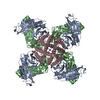 5ebmC 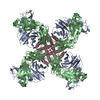 5ebwC 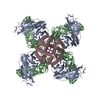 5ec1C 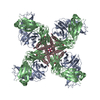 5ec2C  1k4cS C: citing same article ( S: Starting model for refinement |
|---|---|
| Similar structure data |
- Links
Links
- Assembly
Assembly
| Deposited unit | 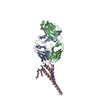
| |||||||||||||||||||||
|---|---|---|---|---|---|---|---|---|---|---|---|---|---|---|---|---|---|---|---|---|---|---|
| 1 | 
| |||||||||||||||||||||
| Unit cell |
| |||||||||||||||||||||
| Components on special symmetry positions |
|
- Components
Components
-Protein , 1 types, 1 molecules C
| #3: Protein | Mass: 13324.719 Da / Num. of mol.: 1 / Fragment: UNP residues 1-125 / Mutation: T75G Source method: isolated from a genetically manipulated source Source: (gene. exp.)  Streptomyces lividans (bacteria) / Gene: kcsA, skc1 / Production host: Streptomyces lividans (bacteria) / Gene: kcsA, skc1 / Production host:  |
|---|
-Antibody , 2 types, 2 molecules AB
| #1: Antibody | Mass: 23411.242 Da / Num. of mol.: 1 Source method: isolated from a genetically manipulated source Source: (gene. exp.)   |
|---|---|
| #2: Antibody | Mass: 23435.738 Da / Num. of mol.: 1 Source method: isolated from a genetically manipulated source Source: (gene. exp.)   |
-Non-polymers , 4 types, 181 molecules 
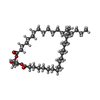





| #4: Chemical | ChemComp-F09 / | ||
|---|---|---|---|
| #5: Chemical | ChemComp-DGA / | ||
| #6: Chemical | ChemComp-K / #7: Water | ChemComp-HOH / | |
-Details
| Has protein modification | Y |
|---|
-Experimental details
-Experiment
| Experiment | Method:  X-RAY DIFFRACTION / Number of used crystals: 1 X-RAY DIFFRACTION / Number of used crystals: 1 |
|---|
- Sample preparation
Sample preparation
| Crystal | Density Matthews: 3.98 Å3/Da / Density % sol: 69.13 % |
|---|---|
| Crystal grow | Temperature: 291 K / Method: vapor diffusion, sitting drop / Details: PEG 400 |
-Data collection
| Diffraction | Mean temperature: 80 K | ||||||||||||||||||||||||||||||||||||||||||||||||||||||||||||||||||||||||||||||||||||||||||||||||||||||||||||||
|---|---|---|---|---|---|---|---|---|---|---|---|---|---|---|---|---|---|---|---|---|---|---|---|---|---|---|---|---|---|---|---|---|---|---|---|---|---|---|---|---|---|---|---|---|---|---|---|---|---|---|---|---|---|---|---|---|---|---|---|---|---|---|---|---|---|---|---|---|---|---|---|---|---|---|---|---|---|---|---|---|---|---|---|---|---|---|---|---|---|---|---|---|---|---|---|---|---|---|---|---|---|---|---|---|---|---|---|---|---|---|---|
| Diffraction source | Source:  SYNCHROTRON / Site: SYNCHROTRON / Site:  ALS ALS  / Beamline: 4.2.2 / Wavelength: 1 Å / Beamline: 4.2.2 / Wavelength: 1 Å | ||||||||||||||||||||||||||||||||||||||||||||||||||||||||||||||||||||||||||||||||||||||||||||||||||||||||||||||
| Detector | Type: RDI CMOS_8M / Detector: CMOS / Date: Mar 12, 2015 | ||||||||||||||||||||||||||||||||||||||||||||||||||||||||||||||||||||||||||||||||||||||||||||||||||||||||||||||
| Radiation | Protocol: SINGLE WAVELENGTH / Monochromatic (M) / Laue (L): M / Scattering type: x-ray | ||||||||||||||||||||||||||||||||||||||||||||||||||||||||||||||||||||||||||||||||||||||||||||||||||||||||||||||
| Radiation wavelength | Wavelength: 1 Å / Relative weight: 1 | ||||||||||||||||||||||||||||||||||||||||||||||||||||||||||||||||||||||||||||||||||||||||||||||||||||||||||||||
| Reflection | Resolution: 2.3→54.947 Å / Num. all: 40541 / Num. obs: 40541 / % possible obs: 100 % / Redundancy: 7.2 % / Rmerge(I) obs: 0.109 / Rpim(I) all: 0.044 / Rrim(I) all: 0.118 / Rsym value: 0.109 / Net I/av σ(I): 6.457 / Net I/σ(I): 13.1 / Num. measured all: 290580 | ||||||||||||||||||||||||||||||||||||||||||||||||||||||||||||||||||||||||||||||||||||||||||||||||||||||||||||||
| Reflection shell | Diffraction-ID: 1 / Rejects: _
|
- Processing
Processing
| Software |
| ||||||||||||||||||||||||
|---|---|---|---|---|---|---|---|---|---|---|---|---|---|---|---|---|---|---|---|---|---|---|---|---|---|
| Refinement | Method to determine structure:  MOLECULAR REPLACEMENT MOLECULAR REPLACEMENTStarting model: 1K4C Resolution: 2.3→38.852 Å / SU ML: 0.29 / Cross valid method: FREE R-VALUE / σ(F): 0 / Phase error: 26.11 / Stereochemistry target values: ML
| ||||||||||||||||||||||||
| Solvent computation | Shrinkage radii: 0.9 Å / VDW probe radii: 1.11 Å / Solvent model: FLAT BULK SOLVENT MODEL | ||||||||||||||||||||||||
| Displacement parameters | Biso max: 101.36 Å2 / Biso mean: 46.6517 Å2 / Biso min: 16.21 Å2 | ||||||||||||||||||||||||
| Refinement step | Cycle: final / Resolution: 2.3→38.852 Å
|
 Movie
Movie Controller
Controller









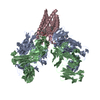
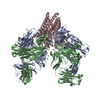


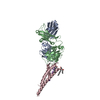

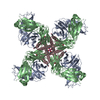
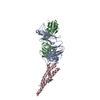





 PDBj
PDBj






